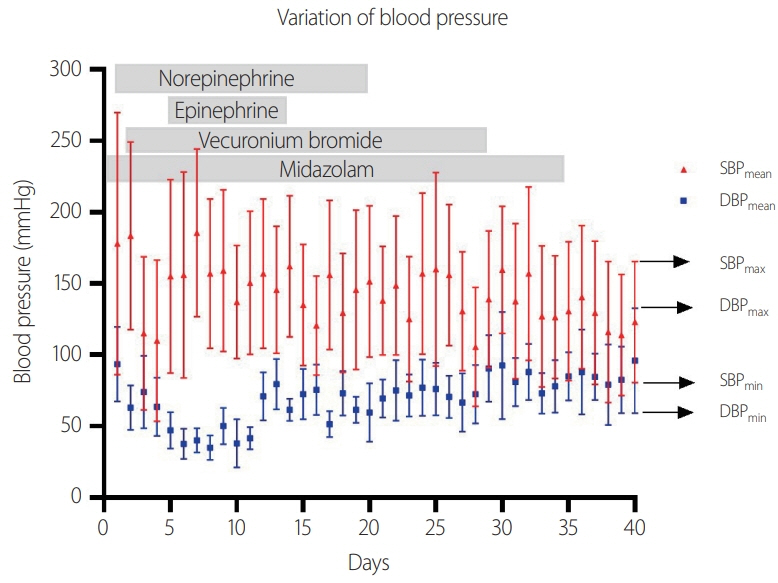Ann Clin Neurophysiol.
2021 Oct;23(2):117-120. 10.14253/acn.2021.23.2.117.
Autonomic instability in severe tetanus: a case report
- Affiliations
-
- 1Department of Neurology, Kosin University College of Medicine, Busan, Korea
- 2Department of Pulmonary and Critical Care Medicine, Kosin University College of Medicine, Busan, Korea
- KMID: 2521889
- DOI: http://doi.org/10.14253/acn.2021.23.2.117
Abstract
- Tetanus is an infectious disease of the nervous system caused by Clostridium tetani, and is characterized by tonic muscle contractions, painful spasms, and autonomic dysfunction. Severe autonomic dysfunction associated with tetanus can be life-threatening. We present a 62-year-old female who experienced lockjaw after an ankle fracture. The patient was diagnosed with tetanus and received tetanus immunoglobulin and a vaccination. The patient subsequently experienced labile hypertension. This case highlights the challenge and importance of managing cardiovascular instability.
Figure
Reference
-
1. Berkowitz AL. Tetanus, botulism, and diphtheria. Continuum (Minneap Minn). 2018; 24:1459–1488.
Article2. Wasay M, Khealani BA, Talati N, Shamsi R, Syed NA, Salahuddin N. Autonomic nervous system dysfunction predicts poor prognosis in patients with mild to moderate tetanus. BMC Neurol. 2005; 5:2.
Article3. Anuradha S. Tetanus in adults--a continuing problem: an analysis of 217 patients over 3 years from Delhi, India, with special emphasis on predictors of mortality. Med J Malaysia. 2006; 61:7–14.4. Korea Disease Control and Prevention Agency. Infectious disease portal report [Internet]. Cheongju, Korea: Korea Disease Control and Prevention Agency;c2021 [accessed 2021 Mar 15]. Available from: http://www.kdca.go.kr/npt/biz/npp/ist/simple/simplePdStatsMain.do.5. Tetanus Abrutyn E. Fauci AS, Braunwald E, Kasper DL, Hauser SL, Longo DL, Jameson JL, editors. Harrison’s principle’s of internal medicine. 17th ed. New York: Mc Graw Hill Inc.;2008. p. 898–900.6. Spruyt GM, Van Den Heever T. The treatment of autonomic dysfunction in tetanus. South Afr J Crit Care. 2017; 33:28–31.7. Farrar JJ, Yen LM, Cook T, Fairweather N, Binh N, Parry J, et al. Tetanus. J Neurol Neurosurg Psychiatry. 2000; 69:292–301.8. Rodrigo C, Fernando D, Rajapakse S. Pharmacological management of tetanus: an evidence-based review. Crit Care. 2014; 18:217.
Article9. Dundee JW, Morrow WF. Labetalol in severe tetanus. Br Med J. 1979; 1:1121–1122.
Article10. Wesley AG, Hariparsad D, Pather M, Rocke DA. Labetalol in tetanus. The treatment of sympathetic nervous system overactivity. Anaesthesia. 1983; 38:243–249.
- Full Text Links
- Actions
-
Cited
- CITED
-
- Close
- Share
- Similar articles
-
- Case Report of Tetanus Which is Treated by Human Tetanus Immunoglobulin 500 Unit
- Localized Tetanus in Legs with Abdominal Pain after Lumbar Radiculopathy Acupuncture Treatment
- Generalized Tetanus Treated with Intrathecal Baclofen Infusion
- Neonatal tetanus
- Specific Immunoglobulin Responses Against Tetanus Toxoid after DPT Vaccination


